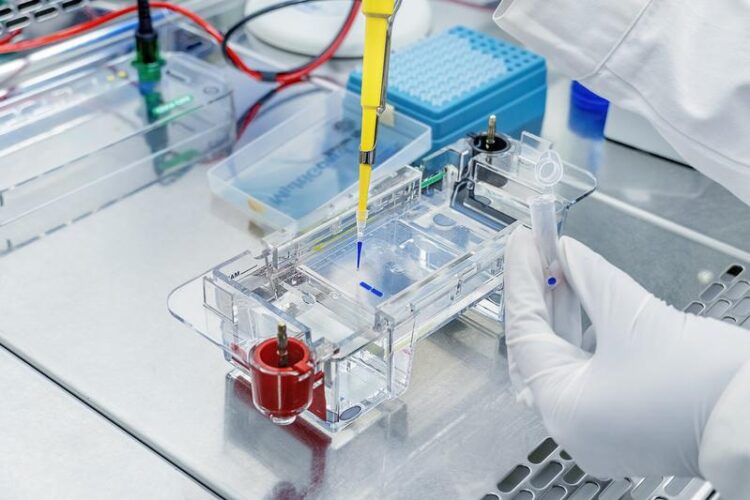New technologies for producing mRNA-based pharmaceuticals

Novel chitosan particles and encapsulation technologies shall help to produce mRNA therapeutics and other medication more efficiently.
Credit: Fraunhofer IPK / Larissa Klassen
Efficient and stable …
mRNA-based vaccines have been one of the key elements in the fight against the coronavirus. The technology was originally developed for cancer therapy and can be used to treat many diseases. Together with partners from science and industry, Fraunhofer IPK is now researching how mRNA therapeutics and other medication can be better produced and more effectively applied.
A major challenge in using RNA molecules for medical purposes is still that they are very quickly degraded enzymatically. This means that without special protection, they cannot persist in a human body long enough to unfold their effect in the right place. For vaccine production, mRNA molecules were encapsulated in a protective lipid shell. However, currently available technologies for generating such lipid nanoparticles and encapsulating the molecules are still limited in their efficiency and stability.
In the project »Targeted and long-term release of active ingredients encapsulated in chitosan nanoparticles«, FDX Fluid Dynamix GmbH, Heppe Medical Chitosan GmbH, Martin Luther University Halle-Wittenberg and Fraunhofer IPK are therefore researching and optimizing novel chitosan particles and auxiliaries in order to make their production more sustainable, environmentally compatible and flexible, and to improve their transport of active ingredients. The project is funded by the German Federal Ministry of Economics and Climate Protection (BMWK) with a total of 6 million euros until the end of 2025.
In order to stabilize the nanoparticles for transporting mRNA therapeutics and other active ingredients, the researchers are investigating the influence of particle composition and process control on the nanoparticle properties. On this basis, they are developing new nanoparticle formulations as well as innovative encapsulation systems, so-called drug delivery systems (DDS) for a controlled local release of active ingredients. As a result of the basic research project, a platform technology is to be developed that will make it possible to precisely control the particle properties and the release time for an mRNA active ingredient.
»The interplay between particle properties, active ingredient and carrier system has not yet been fully explored. By adjusting nanoparticle properties such as size, charge and degradability and identifying a suitable biocompatible carrier matrix, we aim to enable the efficacy of mRNA and other active ingredients over a longer period of time«, says Christoph Hein, head of the Microproduction Technologies department at Fraunhofer IPK. »This way, patients could receive a more effective treatment.«
Stabilizing RNA complexes as well as releasing them locally and controlled is essential in order to exploit the high therapeutic potential of mRNA medicines. This could affect, for example, tumor treatment, but also treatment of local diseases of specific organs such as the eye or inner ear. Furthermore, the intended research results of the project could help to avoid the need for multiple administrations of the active ingredients. As mRNA-based vaccines have shown, this is not yet possible from a technological point of view.
Wissenschaftliche Ansprechpartner:
Christoph Hein | Phone: +49 30 39006-405 | christoph.hein@ipk.fraunhofer.de
Weitere Informationen:
Media Contact
All latest news from the category: Life Sciences and Chemistry
Articles and reports from the Life Sciences and chemistry area deal with applied and basic research into modern biology, chemistry and human medicine.
Valuable information can be found on a range of life sciences fields including bacteriology, biochemistry, bionics, bioinformatics, biophysics, biotechnology, genetics, geobotany, human biology, marine biology, microbiology, molecular biology, cellular biology, zoology, bioinorganic chemistry, microchemistry and environmental chemistry.
Newest articles

First-of-its-kind study uses remote sensing to monitor plastic debris in rivers and lakes
Remote sensing creates a cost-effective solution to monitoring plastic pollution. A first-of-its-kind study from researchers at the University of Minnesota Twin Cities shows how remote sensing can help monitor and…

Laser-based artificial neuron mimics nerve cell functions at lightning speed
With a processing speed a billion times faster than nature, chip-based laser neuron could help advance AI tasks such as pattern recognition and sequence prediction. Researchers have developed a laser-based…

Optimising the processing of plastic waste
Just one look in the yellow bin reveals a colourful jumble of different types of plastic. However, the purer and more uniform plastic waste is, the easier it is to…



